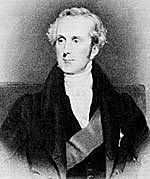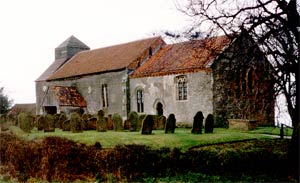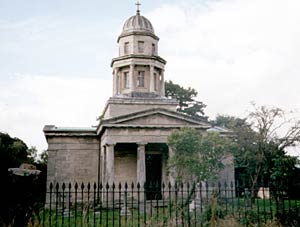< Previous | Contents | Next >
The Tyrant Lord
MARKHAM CLINTON. (We may call it West Markham.) It lies near the Great North Road, in sight of three windmills in rather sorry plight.

The 4th Duke of Newcastle.
Here in stone and marble is the sequel to one of the strangest chapters in 19th century social history, a chapter based on the text: Is it not lawful for me to do what I please with mine own? To do as it seemed lawful to him the fourth Duke of Newcastle, last of the feudal autocrats, caused an ancient church to be deserted and fall into decay, transferring the worshippers to a church of his own, which he summoned Sir Robert Smirke, architect of the British Museum, to build for him half a mile away.

West Markham church in 1982.
The old church was being slowly restored at the time we called, to be a more fitting shrine for its treasures. In a churchyard with fine chestnut trees, its grey walls and red roof, with Elizabethan timbering in the bell-turret and the porch, rise in simple dignity above the wayside. It is said to have been founded by Roger de Builly, and some of the Norman work is still here. In the Norman doorway hangs an old oak door on its old hinges. There is a Norman shaft piscina, and joyous work of these master carvers remains on the fine Norman font, in whose arcading are seven happy figures, one a priest with a chalice, two holding books, some in cloaks, and some in belted gowns.
A few windows are medieval, and a piscina is 16th century. The roofs have new beams and three old carved bosses, one with a crowned man, one with a grotesque showing his tongue. There are six very high old oak benches, altar rails and a chest of the 17th century, and an old pillar almsbox. The old altar stone, more than seven feet long, is still here, and a venerable ladder which may even be Saxon has new rungs 19 inches apart.
With her cushioned head guarded by battered angels, and a grotesque figure at her feet, a lady lies here carved in stone; she was perhaps one of the Lascelles who were lords of the manor till the time of Henry the Eighth. Signs of their moated house are in the Old Hall Field south of the church.

Markham Clinton church in 1998.
The church built by the fourth duke in 1831 as a resting-place for the Clintons has nothing so beautiful as the road bringing us to it, a fine avenue of limes shading the way to the hamlet of Milton. Like a classical temple outside, with four columns supporting a pediment, it is depressing inside, and apart from the monuments in a chamber at the east end its only interest is in an Elizabethan pulpit and an old altar table.
The duke's wife, Georgiana Elizabeth, a great heiress who died in 1822 when only 33, has a marble monument by Westmacott showing her reclining on a mattress with the two babes for whom she sacrified her life, though they were buried with her. She gazes, as if anxious to follow, at a figure in gossamer drapery carved above the tomb; it is the figure of one of her many children (Anna Maria) who had died not long before her. Here, with a wall monument, sleeps her tyrant lord, the fourth duke, who throughout his life fiercely opposed civil and religious reform, and never more angrily than when the Reform Bill took from him the right to return members for six pocket boroughs. In 1829, with a friend, he evicted 40 Newark burgesses for voting against his nominee; but three years afterwards he brought Mr Gladstone into Parliament for the same borough (Gladstone's first election, of which we may see many relics in the Newark Museum), only to turn him out later because he was angry with Free Trade. His treatment of his tenants was raised in the House of Lords, where he haughtily answered that he would do as he liked with his own. Nottingham Castle, which he owned, was burned down by the Reform Bill rioters. He fortified Clumber and his London house, but in 1839 he was dismissed from the lord-lieutenancy of the county and informed that the Queen had no further use for him.
Dying in 1851 at 68, he was succeeded by his more liberal son, a statesmen who held office under Peel, Aberdeen, and Palmerston, and was buried here in 1864 after dying suddenly at Clumber. His inscription, with that of the sixth duke who followed him to the grave 11 years later, is on the fourth duke's monument, the three inscriptions flanked by lifesize figures with bowed heads crowned, one with a peacock, the other with five feathers.
